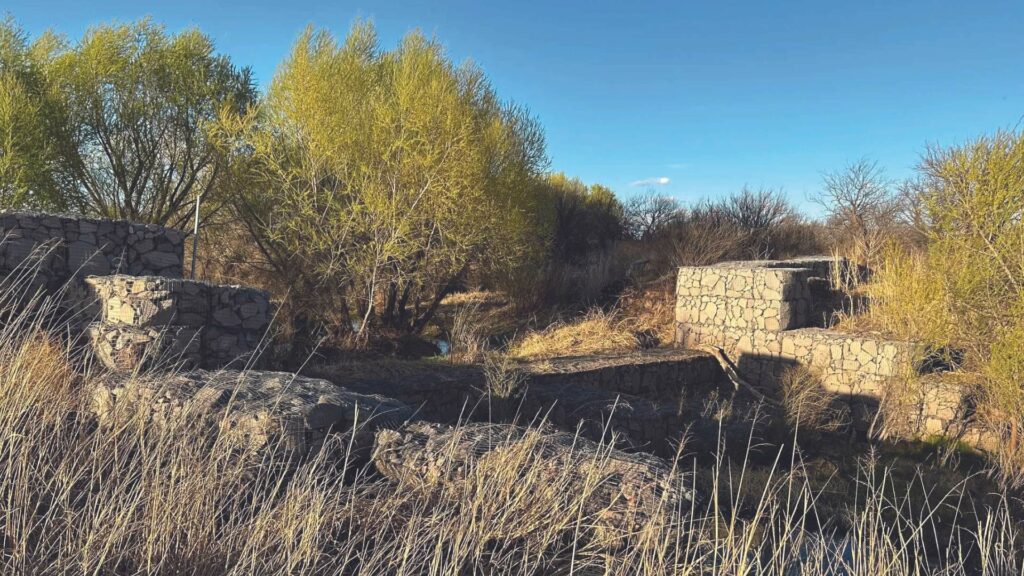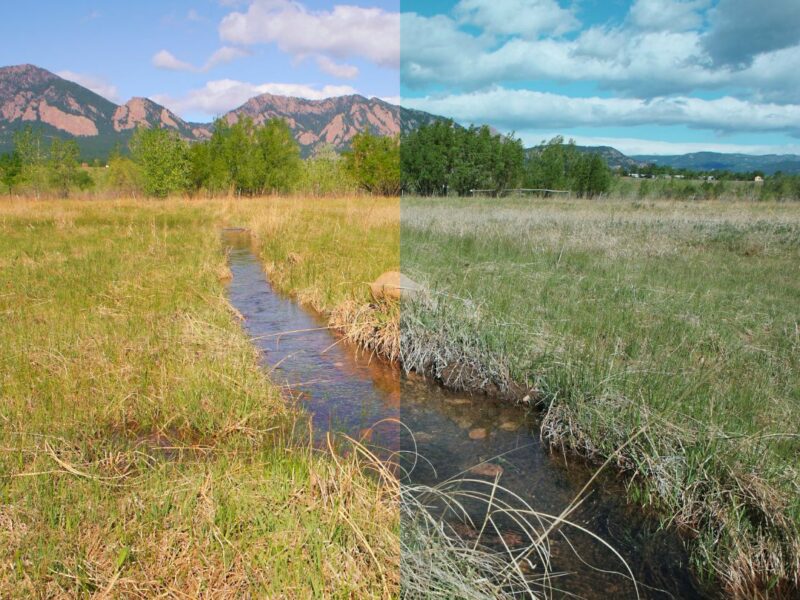Landowner innovation and long-term research is showing that low-tech restoration practices not only capture more rainwater, they may create more rain.
In the desert of southern Arizona lies a remarkable story of regrowth. Beginning in the 1980s, Valer Clark and Josiah Austin embarked on a journey to revitalize their newly acquired land and the cattle operation that depended on it. It started when Austin placed some rocks, large enough to require a considered lift, but small enough to move by hand, into a wash that had eroded one of their roads. Later that summer, Austin and Clark observed that around those rocks, the plants were still green, while most everything else had withered and died in the brutal Chihuahuan desert heat. This simple but effective technique, repeated thousands of times over the coming years, would not only transform the land but would help inspire a movement throughout the West.
Prior to Clark and Austin’s work, the lands of El Coronado Ranch, like the neighboring ranches, were seasonally victimized by heavy monsoon rains that charged through arroyos and washes, scouring deeper and deeper channels with each passing year. These check dams, also known as “trincheras” by locals, and the vegetation they helped establish, slowed the water down. As they saw the effects of the structures throughout the tributaries and main stem of Turkey Creek, the small stream that runs through the property, their makeshift solution to combat the effects of erosion soon blossomed into a full-fledged land restoration project.
The more structures they put in, the more the effects multiplied, transforming the once-barren landscape into a thriving corridor of greenery.
When the water slowed down, it dropped its sandpaper sediment and the bird poop, cow manure and decayed plant matter that came with it behind the check dams. The more structures they put in, the more the effects multiplied, transforming the once-barren landscape into a thriving corridor of greenery. In the years since this work, Clark founded the nonprofit organization Cuenca Los Ojos, which teaches these restoration practices to landowners and community members, while managing 121,000 acres of protected land in Northern Mexico, south of the border with Arizona.
“Life here revolves around water. Drawing inspiration from the age-old practices of indigenous inhabitants, we’ve rejuvenated free-flowing rivers and arid wetlands, revived the land and soil, and restored critical habitat for diverse wildlife,” said Valerie Gordon, the daughter of Valer Clark, and interim executive director of Cuenca Los Ojos (Gordon is also a board member of the Western Landowners Alliance). “If water, soil and life can reverse negative climate impacts here, it can work anywhere.”

Gabion installed at Cienega San Bernardino, Sonora, Mexico, March 2023, looking upstream. Photo by Laura Norman/USGS.
Old practices renewed
Using what scientist Laura Norman has termed “natural infrastructure in dryland streams,” or NIDS, to slow water, reverse desertification and capture nutrient-rich sediment is nothing new. The indigenous people of the American Southwest have used these practices for thousands of years. However, until the work at El Coronado Ranch came to the attention of Norman on a field trip in the early 2000s, the impacts of these techniques on watersheds had largely gone unstudied.
Norman, a supervisory research physical scientist at the U.S. Geological Survey, has since spent years studying the rock structures and natural infrastructure projects at El Coronado Ranch and other sites in the region, including some managed by Cuenca Los Ojos, seeking to understand and quantify the effects they have on the water cycle, soil health and vegetation. NIDS is a catch-all term Norman coined to include everything from beaver dams to log piles to willow weirs to one-rock dams. The point is that they are low-cost, low-tech, nature-based solutions, she said, and they offer multiple co-benefits. Norman’s research has shown they play a crucial role in maintaining or restoring a healthy hydrological cycle and mitigating the impacts of drought and desertification. And they are a solution that is accessible and affordable to anyone with a piece of land on which water sometimes falls.
Local water cycle
If the outcomes weren’t so evident to the naked eye, the numbers that Norman’s research has produced might be hard to believe. Check dams in the Turkey Creek watershed hold back nearly 200 tons of soil each year, capturing as much soil carbon per acre as coastal wetlands. They cut the average rate of flow in half, primarily by slowing flash flood events dramatically. They extend the base flow of Turkey Creek four weeks later into the dry season. Perhaps most remarkably, they have also increased the stream’s overall volume by an astonishing 28%.
This increase in water volume is “appearing” in the landscape for a variety of reasons that Norman has sought to understand and tease apart. Rock detention structures are able to hold cool temperatures in hot climates following rainfall. There is a cooling effect from increased vegetation, lowering evaporation. And the increased water storage capacity of carbon-rich living soils that NIDS offer show great promise for dryland streams.
“Our journey has been one of continuous learning over several decades, enabling us to reverse desertification and restore the water, soil and vegetation of this amazing landscape.”
— Valer Clark
“By returning soil and water to these lands, we’re now witnessing the resurgence of grass on the uplands and the growth of trees in riparian areas,” said Valer Clark. “This growth plays a vital role in replenishing soil moisture and facilitating a healthy and self-sustaining water cycle. Our journey has been one of continuous learning over several decades, enabling us to reverse desertification and restore the water, soil and vegetation of this amazing landscape.” Similar efforts to improve the health of the soil, grasses and hydrology of working lands are being implemented across the Sky Island Restoration Collaborative, which includes Cuenca Los Ojos, and studied by Norman and other researchers.


Regional rainmaker network
Alejandro Carrillo, Cuenca Los Ojos Board member and fourth-generation rancher in the Chihuahuan desert in Mexico, is on a mission to restore the water cycles on his Las Damas Ranch by combining NIDS with adaptive grazing to nurture the soil. By cultivating a vibrant ecosystem characterized by diverse perennial grasses, forbs and trees, Carrillo has created a landscape that infiltrates 300% more water than neighboring ranches. In a region that gets only seven inches of rain a year, that increase makes a major difference.
More surprisingly, perhaps, Carrillo and his research partners have noticed that his landscape appears to enrich the clouds. “Multiple-year radar data and actual measured precipitation indicate that the vegetation being produced on these regenerative ranches is generating rain that is highly concentrated over” those same ranches, he wrote last year. It looks like his neighbors’ gripes that it always seems to rain more on his side of the fence are actually rooted in reality: The healthier soils and vegetation on Las Damas Ranch are generating 10 to 20% more rain than the region’s average.
Global picture
The question remains, are these powerful local and regional stories of regreening the desert outliers, or the signal of what’s possible everywhere in the arid West? How dependent on favorable precipitation cycles and regional climate patterns are these restoration successes? Global climate and weather modelers, like David Lawrence of the National Center for Atmospheric Research (NCAR) in Boulder, Colorado, are trying to find out.
Lawrence, who runs the Terrestrial Sciences Section of the Global Dynamics Lab at NCAR, said, “We do know that healthy soils, organic rich soils, are great at holding water.” But the relationships between healthy soils and the regional and global climate and weather patterns are less well understood. Global models agree that more vegetation, especially healthy forests, reduces surface temperatures. “But [the models] don’t agree on the precipitation response,” Lawrence said.
What is more troubling is when the models agree with each other, but don’t agree with actual observations. In all climate simulations, Lawrence’s team has found, “The predominant signal … is an increase in atmospheric water vapor” over the arid and semiarid regions of the world, including the American West, because warmer air can hold more water vapor. But, in fact, the air in these regions is remaining drier than predicted, they wrote, “suggesting that the availability of moisture to satisfy the increased atmospheric demand is lower in reality than in models.” This finding is bad news for forecasts of wildfire risk in the West, for example, because it means climate models have likely been underestimating the danger.
But the model simulations examined by Lawrence’s team also point to a more hopeful prospect as well, one that may explain the rainmaking power of the Cuenca Los Ojos projects. More available moisture on the landscape would mean more moisture in the atmosphere. More atmospheric moisture would mean more rain, somewhere. More vegetation, especially trees, according to other research, seeds the atmosphere with cloud-building biota and chemicals (this is the same physics behind artificial cloud seeding, which has been studied extensively). The heavier the local cloud seeding, the higher the chance of local rain or snow. In other words, as Spanish meteorologist Millan Millan put it, “Water begets water. Soil is the womb. Vegetation is the midwife.”
Of course, all this depends a lot on which way the wind blows, so you can see the difficulty of making predictions. These relationships between land, water and climate are as unique as the shape and surface of every valley on Earth. That makes both modeling them and observing them accurately at a global scale incredibly challenging. But that shouldn’t stop us from trying to make rain, Lawrence said. Every restoration project, big or small, matters. “Everything we do has consequences downstream,” he noted. “The interconnectedness of it all is really critical. That’s what we continually learn about the climate system, is how interconnected everything is. And just how those interconnections are so hard to anticipate.”
Sorry, the comment form is closed at this time.






Dan Stroud
I’ve been following the work they’ve been doing in the area for years and am amazed at what can be done by groups working together.
Leonor Couper
Please can we have more pictures … a picture speaks 1000 words?
Thank you